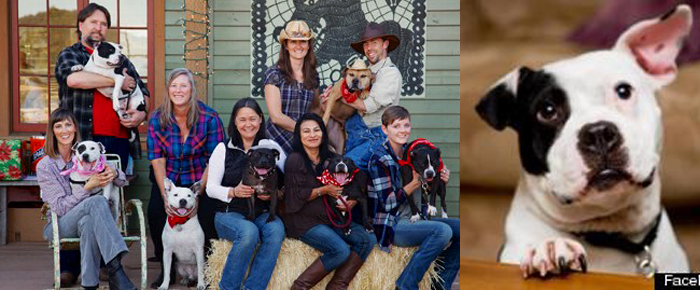
By Janet McAfee
I hesitate to call them the “Vick” dogs, not wanting to use the name of the man who tortured and brutally killed their kennel mates in one of the nation’s most notorious dog fighting rings. They are better described as the Victory Dogs, animals that overcame the most horrendous of conditions to heal and triumph over their past.
There were 50 live dogs rescued from NFL quarterback Michael Vick’s Virginia property, Bad Newz Kennels, when he pled guilty to federal dog fighting charges. The dogs were scarred, both physically and emotionally, and their fate was uncertain. In 2007, when the Vick case hit the news, it was a standard policy to euthanize all animals seized in a fighting raid. Many voices, some even coming from the animal welfare community, called for these dogs to be euthanized. Some argued that the funds and effort expanded on them could be better spent on other “less damaged” shelter dogs.
Only one of the Vick dogs had to be euthanized for aggressive behavior. The massive rehabilitation of these dogs, and the amazing transformation of almost every one of them, changed the way many (though not all) public and private organizations evaluate dogs seized in fighting raids. The trend today is to evaluate each seized animal on an individual basis. The world acquired valuable knowledge about dog behavior and i’s ability to change.
The surviving Vick dogs went to various animal welfare organizations including Best Friends, BAD RAP, Richmond Animal League, and SPCA for Monterey that were screened for their ability to train and rehabilitate. This was a nationwide experiment as a group of rescued fighting dogs had never had their resilience tested like this before. It took time, patience, training and love. The outcome was nothing short of miraculous
Seven of the ten dogs that went to BAD RAP in Oakland, California, were reunited for a happy celebration on October 27, 2013. The dogs cheerfully wagged their tails, surrounded by their proud owners and 125 guests. It was a touching sight to see the sheer happiness in the dogs, as they recognized their similarity and perhaps remembered each other from their shadowy past.
Donna Reynolds, director of BAD RAP, describes the dogs, “They’re very forgiving and they all really enjoy other dogs which, is probably the big surprise that came out of the case. In fact, the other dogs were a comfort to them.” Reynolds added, “Dogs live in the moment, they don’t dwell on the past. Once they have enough positive experiences to draw on, they just run right into the present.” These animals have much to teach us humans.
During the 2007 legal case, BAD RAP worked with prosecutors to help evaluate the dogs. Eventually the group secreted 10 of them out in the back of any RV due to the ongoing investigation. All of these 10 eventually went to good homes and are doing well. Three of them did not attend the reunion, one because of distance, and another due to a last minute emergency of his owner. Ernie stayed home enjoying just being a regular dog as his mom didn’t want him identified anymore as a “Vick” dog.
The seven attending dogs all have Canine Good Citizen Certificates. Three work as therapy dogs in hospitals. One dog, Jonny Justice, worked in a children’s reading program in Northern California. This handsome black and white dog was recently named “the most beautiful dog in the country” in a contest sponsored by GUND, and there is now a plush doggie toy made in Jonny’s likeness.
Hector, a large brown dog, came to BAD RAP with scars on his chest and legs. He turned out to have a sterling demeanor, and if not for his age would have been considered for a career in law enforcement. Hector was adopted by Roo Yori of Minnesota. Yori is known in the pit bull world as the keeper of Wallace, national flying disc champion. Hector bonded with Wallace as well as with Yori’s menagerie of five dogs of various breeds. Like many of the Bad Newz refugees, the dog is a bit of a klutz with a mischievous streak and loves to play hide and seek. His mission today is to comfort patients in nursing homes and educate people about pit bulls.
Traci who adopted one of the dogs from Best Friends reports, “Through positive reinforcement and an awesome trainer, I watched Halle learn to trust again and overcome a lot of fears. When she first came home, she would pancake to the ground and shake whenever I took her to a new place or introduced her to a new person. Now she will sit on the couch next to a stranger and paw at them so they will pet her…She has taught me great lessons about resiliency, forgiveness, and unconditional love.”
You can read more about the forty-seven dogs who survived this dog fighting operation in the marvelous book by Jim Gorant, THE LOST DOGS. The book makes a great Christmas present for dog lovers. THE LOST DOGS chronicles the fighting operation, the evolution of the legal case, and the stories of some of the dogs. It exposes the terrible practice of dog fighting, and shows us that even after being exposed to heart breaking abuse, above all, a dog still wants to be man’s best friend.








































